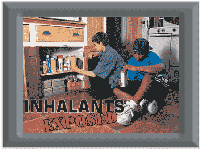Teens favor inhalants and switch over to worst drugs
A new report released by the federal government shows preteens and young teenagers like using inhalants and often move on to more harmful drugs.

Drug users as young as 12- and 13-years-old are sniffing household chemicals to become high, according to the National Inhalant Prevention Coalition.
Then, they move on to drugs such as marijuana or painkillers.
“Inhalants are everywhere in the house and garage, and parents often do not realize that glue and paint are not being used for crafts or science projects,” said Dr. H. Westley Clark, Substance Abuse and Mental Health Statistics director of the Center for Substance Abuse Treatment in a news release.
In the news release, Clark said the inhalants can damage the brain, liver, heart, or kidneys – and can even have fatal consequences.
The report is based on a national survey, which looked at individuals aged 12 and 17 between 2002 and 2006.
The data showed an annual average of 593,000 teenagers had used inhalants for the first time in the year before the survey.
Of those surveyed, 21 percent said they used an illicit drug in the past year.
The 12- and 13-year-olds said inhalants were the most “illicit” drug used in the past year, while marijuana was favored among older teenagers, it was reported.
Shoe polish, glue and toluene were the most popular inhalants, according to the survey.
Inhalants are drugs in the forms of gas aerosols, or solvents, which are inhaled as a vapor. Inhalant drugs are used for both medical purposes and as recreational drugs for their intoxicating effect; this article focuses on the use of inhalants to create psychoactive effects. Inhalants used as recreational drugs include organic solvents from cleaning products and glues and propellant gases from aerosol cans. Some inhalants, such as ether, nitrous oxide, and alkyl nitrites, have been widely used both medically and recreationally.
The effects of recreational solvent inhalation can range from an alcohol-like intoxication and euphoria to hallucinations. The use of inhalants can cause injuries and, in some cases can lead to death. Nonmedical inhalant use is restricted and even criminalized in some jurisdictions, often by forbidding the sale of commonly-used products, such as contact cement, to minors. However, since solvents and aerosol propellants are used in a wide variety of household products, these restrictions have only a limited effect.
Subscribe to Pravda.Ru Telegram channel, Facebook, RSS!


